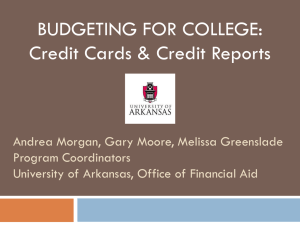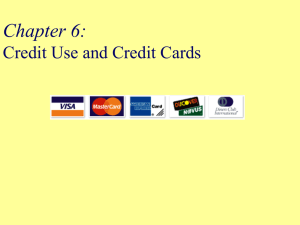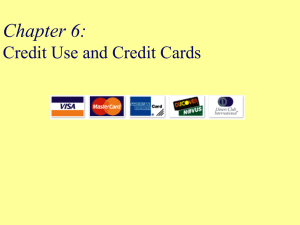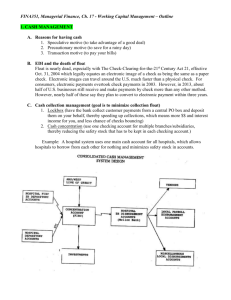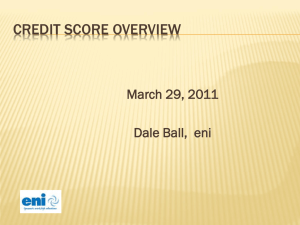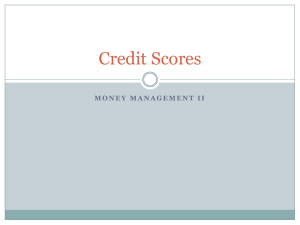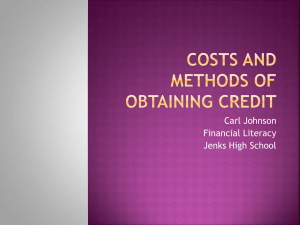CREDIT SCORES - MR. Chavez`s Class
advertisement
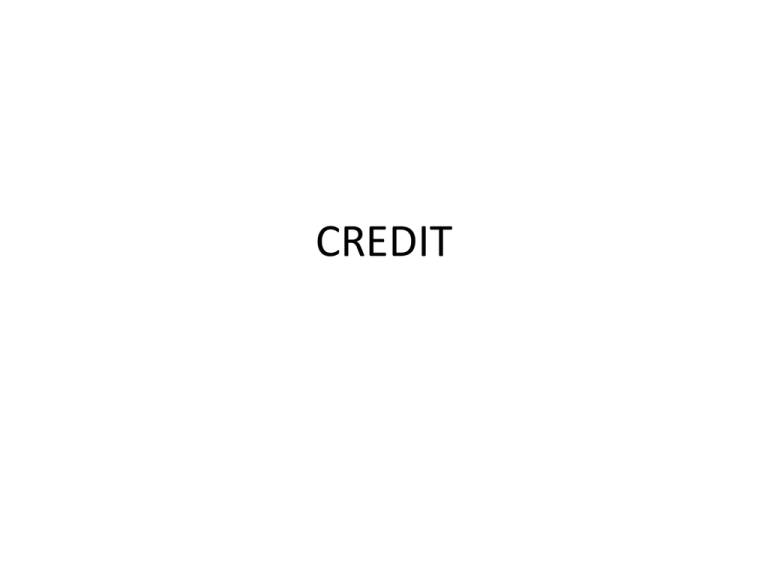
CREDIT • Most debt is mortgage based (considered good debt) Cnn.com • Student Loans are also considered good debt “IF” it does not represent more than 20% of income post education • The average American household with at least one credit card has nearly $15,950 in credit-card debt (in 2012) • 35% of Americans have debt in Collections (180 days past due) • The 77 million Americans with debt in collections owe an average of $5,200. • That includes debt from credit card bills, child support, medical bills, utility bills, parking tickets or membership fees. WHY IS IT IMPORTANT • USED TO DETERMINE WHAT INTEREST RATE YOU WILL RECEIVE FROM A LENDING INSTITUTION. • FOR:CAR LOANS, HOME LOANS, CREDIT CARDS, RENTING APARTMENTS • SAVE YOU A LOT OF MONEY IN INTEREST • ALSO SOME COMPANIES ARE CHECKING CREDIT SCORES FOR EMPLOYMENT • national average annual percentage rate, or APR, on a 30-year fixed-rate mortgage based on their FICO score • between 760 and 850 is 3.15 percent. • For a person with a credit score between 620 and 639, the national average APR is 4.74 percent. •FICO • The Fair Isaac Corp. What is a credit score? • A credit score is a number that summarizes the historical credit information on your personal credit report. The number reflects the likelihood that you will become delinquent on a loan or a credit obligation in the future. Basically telling people how responsible you are. BASICALLY What are the minimum requirements for a FICO score? There's really not much to it; in order for a FICO® score to be calculated, a credit report must contain these minimum requirements: • At least one account that has been open for six months or more • At least one undisputed account that has been reported to the credit bureau with in the past six months • No indication of deceased on the credit report (Please note: if you share an account with another person this may affect you if the other account holder is reported deceased). HOW IS IT CALCULATED 1. 35 % of the score is based on your payment history. The score is affected by how many bills have been paid late, how many were sent out for collection and any bankruptcies. When these things happened also comes into play. The more recent, the worse it will be for your overall score. 2. 30 %of the score is based on outstanding debt. How much do you owe on car or home loans? How many credit cards do you have that are at their credit limits? The rule of thumb is to keep your card balances at 25 percent or less of their limits. 3. 15 % of the score is based on the length of time you've had credit. The longer you've had established credit, the better it is for your overall credit score. 4. 10 % of the score is based on new credit. Opening new credit accounts will negatively affect your score for a short time. This category also penalizes hard inquiries on your credit in the past year. 5. 10 % of the score is based on the types of credit you currently have. It will help your score to show that you have had experience with several different kinds of credit accounts, such as revolving credit accounts and installment loans. Ex. Car loans, student loans, credit cards, RANGE OF CREDIT SCORES • • • • • • • • 499 and below 2 % 500-549 5 % 550-599 8 % 600-649 12 % 650-699 15 % 700-749 18 % 750-799 27 % 800 and above 13 %- GET THE BEST RATES Is there one score? • • One of the most common myths about credit scores is that there is only one credit score. In fact, there are many different credit scores used by lenders (according to some estimates, more than 1,000), although some scores are used more than others. • Credit bureau scores are not the only scores used. • Many lenders use their own credit scores, which often will include the FICO score as well as other information about you. • FICO scores are not the only credit bureau scores. • Your credit score may be different at each of the main credit reporting agencies. • Main reporting bureaus Experian, Equifax, Transunion Can you fix a credit score? • The first step is to pull your credit report Make sure none of the following are on your report: • Late payments, charge-offs, collections or other negative items that aren‘t yours. • Credit limits reported as lower than they actually are. Accounts listed as "settled," "paid derogatory," "paid charge-off" or anything other than "current" or "paid as agreed" if you paid on time and in full. • Accounts that are still listed as unpaid that were included in a bankruptcy. • Negative items older than seven years (10 in the case of bankruptcy) that should have automatically fallen off your reports. Where do I go to get info • Annualcreditreport.com • Government sponsored site and you get one report free each yr. • Need current information • Address and numbers of each reporting bureau are listed I’m Ready • Go to the bank you are currently with. They are more likely to issue you a card. • Average credit line $500 • Secured Credit Card- A pre-paid card “not the Rush Card” that you utilize like a credit card. • If you default your deposit is used to pay of debt • After 12 months you will typically qualify for a traditional credit card. • People establishing or re-establishing credit • Parents may help you establish credit by allowing to “piggy back on their card” • Pro- parents will be aware of your spending • Cons- If you fail to pay it will impact your parents credit history and will be reported to the credit agencies How to read your statement • If your card has been issued by your bank then you can view your statement on their on-line banking web-site • For other card companies “Discover” statements can be mailed or most people receive an online notice with an account opened with their credit card company. • ATT: Destroy all documents • The stated rate is not your actual interest rate. The advertised rate on a credit card is often the card's simple interest rate. The effective interest rate, however, is your true cost of borrowing. It should include annual feesyou pay to use the card. The compounded interest rate is a better barometer of your effective interest rate. Real & Hidden Costs • Banks can change terms when ever they want • This includes interest rates, lowering your limit and closing your account • http://www.bankrate.com/calculators/managi ng-debt/minimum-payment-calculator.aspx Just making the Ave. Monthly Balance 13.0% 15.0% $1,000 $130 $150 $5,000 $650 $750 $10,000 $1,300 $1,500 • Purchase APR: This is the most common type of APR. Purchases made to the credit card will have a purchase APR calculated. This is the yearly amount of interest charged on purchases carried month to month . • Cash Advance APR: A cash advance is when a cardholder withdraws cash from an ATM or bank using the card, or writes and cashes a check against his or her credit card. Credit card companies charge a specialized APR against this type of transaction. The cash advance APR is commonly higher than the purchase APR. • Balance Transfer APR: A balance transfer is an opportunity for an individual to pay off the balance of one credit card using another credit card. Balance transfer APRs may offer a special introductory offer, such as zero percent for the first six months. • Each of area will be assessed its own interest rate and are calculated into you monthly payment. • So basically you are paying on 3 lines of credit!
